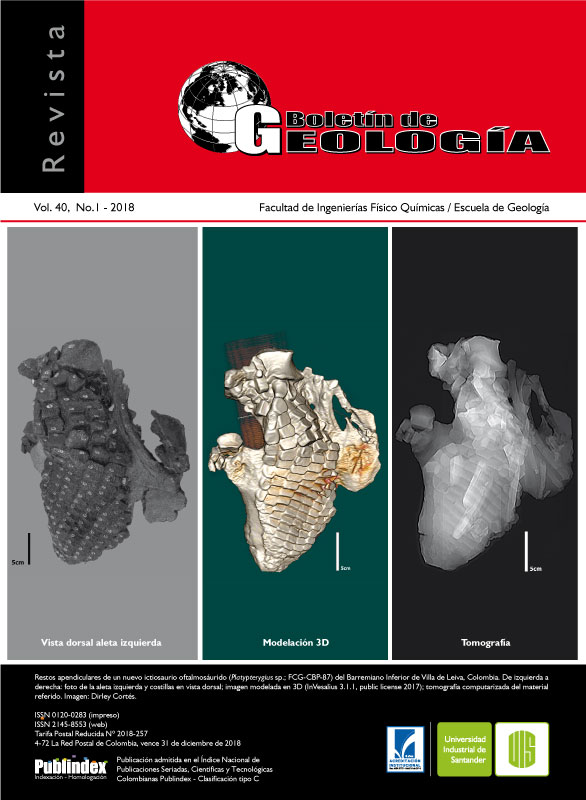Geochemical correlation between oils and rocks of the petroleum system of the Santa Elena peninsula and the gulf of Guayaquil
Published 2018-02-23
Keywords
- geochemistry,
- source rock,
- thermal maturity,
- Gulf of Guayaquil,
- Ecuador
How to Cite
Altmetrics
Abstract
The southeastern of the Ecuadorian coast is a traditionally oil producing region, but the petroleum system has not been defined yet. The proposed main source rocks are Seca and Socorro formations (Eocene) and Dos Bocas and Subibaja formations (Miocene). In order to contribute new elements to the knowledge of the area, both crude and rock from onshore and offshore fields were studied, using geochemical techniques that include gas chromatography
and carbon isotopes. Parameters such as the Carbon Preference Index (IPC), Pri/n-C17 and Phy/n-C18 ratios and the isotopic distributions, indicate that onshore oils are genetically differentiated from offshore oils and are associated with a detritic source rock with mixed organic matter, deposited in a suboxic environment, consistent with the distal area of an estuarine complex. On the other hand, the rocks analyzed are thermally immature and with very low
generating potential, so that they cannot be correlated with the crude analyzed, as was traditionally done.
Downloads
References
Benítez, S. (1995). Évolution géodynamique de la province côtiere sud-équatorienne au Crétacé supérieur-Tertiaire. Geologie Alpine, 71, 3-163.
Cobos, L. (2010). Estudio integrado del Golfo de Guayaquil del Mioceno al Reciente. Tesis de Grado. Facultad de Ingeniería en Ciencias de la Tierra. Escuela Superior Politécnica del Litoral. Ecuador.
Deniaud, Y. (1998). Evolución tectono-sedimentaria de las cuencas costeras Neógenas del Ecuador. Convenio Petroproduccion / ORSTOM. Informe Interno. Quito, Ecuador.
Deniaud, Y., Baby, P., Basile, C., Ordoñez, M., Montenegro, G., and Mascle, G. (1999). Ouverture et évolution tectono-sedimentaire du golfe de Guayaquil: Bassin d’avant-arc néogène et quaternaire du Sud des Andes équatoriennes. Comptes Rendus de l’Académie des Sciences - Series IIA - Earth and Planetary Science, 328(3), 181-187. doi: 10.1016/S1251-8050(99)80094-9.
Escobar-Navarro, M. (2008). Fundamentos de la Geoquímica del Petróleo. XI Congreso Latinoamericano de Geoquímica Orgánica, Isla de Margarita, Venezuela.
Huang, W., and Meinschein, W. (1979). Sterols as ecological indicators. Geochimica et Cosmochimica Acta, 43(5), 739-745. doi: 10.1016/0016-7037(79)90257-6.
Hunt, J.M. (1996). Petroleum geochemistry and geology. (2nd Edition). San Francisco: Freeman and Company.
Jaillard, E., Lapierre, H., Ordóñez, M., Toro, J., Amórtegui, A., and Vanmelle, J. (2009). Accreted oceanic terranes in Ecuador: southern edge of the Caribbean Plate?. Geological Society, London, Special Publications, 328, 469-485. doi: 10.1144/SP328.19.
Jaillard, E., Sempere, T., Soler, P., Carlier, G., and Marocco, R. (1995). The role of Tethys in the evolution of the northern Andes between Late Permian and Late Eocene times. In A.E.M. Nairn, L.E. Ricou, B. Vrielynck, J. Dercourt (Eds.), The Tethys Ocean (pp. 463-492). Boston: Springer.
Lijmbach, G. (1975). On the origin of petroleum. 9th World Petroleum Congress. Tokyo, Japan.
Marksteiner, R., and Alemán, A. (1991). Coastal Ecuador technical evaluation agreement. Peroecuador, Guayaquil. Informe Interno. AMOCO.
Moustafa Y. (2004). Environmental assessment of petroleum contamination of Gamasa-Damiette Beaches. Oriental Journal of Chemistry, 20(2), 219-226.
Moustafa, Y., and Morsi, R. (2012). Biomarkers. In S. Dhanarasu (Ed.), Chromatography and its applications (pp. 165-186). Croatia, Rietja: InTech.
Peters, K.E., Walters, C.C., and Moldowan, J.M. (2005). The Biomarker Guide. Vol. 2. New York: Cambridge University Press.
Sofer, Z. (1984). Stable carbon isotope compositions of crude oils: Application to source depositional environments and petroleum alteration. AAPG Bulletin, 68(1), 31-49.
Wallrabe-Adams, H. (1990). Petrology and geotectonic development of the Western Ecuadorian Andes: the Basic Igneous Complex. Tectonophysics, 185(1-2), 163-182. doi: 10.1016/0040-1951(90)90411-Z.
Vieth, A., and Wilkes, H. (2010). Stable isotopes in understanding origin and degradation processes of petroleum. In K. N. Timmis (Ed.), Handbook of hydrocarbon and lipid microbiology (pp. 97-111). Berlin: Springer.

